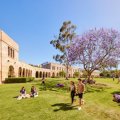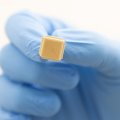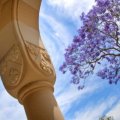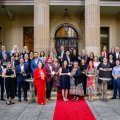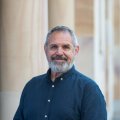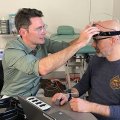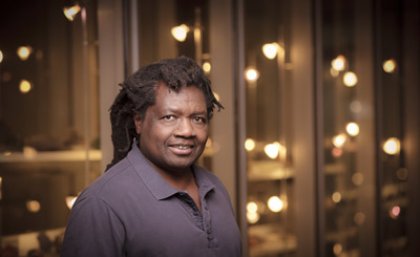
Two UQ researchers will receive national recognition for mining and medical feats at a technological science award night in Sydney tonight.
Professor Stuart Crozier and Professor Gideon Chitombo will receive the Australian Academy of Technological Sciences and Engineering (ATSE) Clunies Ross Awards.
UQ attracted two out of the four awards on offer this year.
The awards recognise outstanding achievement in the application of science and technology for the benefit of the wider community.
Please find below more background on the winners in two press releases (Professor Stuart Crozier release and Professor Gideon Chitombo release).
UQ researcher wins top Australian award for MRI technology
University of Queensland (UQ) Professor Stuart Crozier, who enhanced the MRI machines’ ability for early detection of diseases, received a top Australian award in technological sciences in Sydney, tonight.
Professor Crozier received the Australian Academy of Technological Sciences (ATSE) Clunies Ross Award for his 20-years of contributions to the field of Magnetic Resonance Imaging.
The award recognises outstanding achievement in the application of science and technology for the benefit of the wider community.
Working not only with industry, but also with clinicians and patients, Professor Crozier said he was extremely honoured to receive such an acclaimed award.
“It is particularly pleasing to see an engineering discovery that has had an impact on healthcare be acknowledged by this award. It is also a great recognition for the talented team of people involved,” Professor Crozier said.
Professor Crozier’s first major contribution was the development of signal correction technology to improve the resolution of MRI (Magnetic Resonance Imaging) machines, resulting in an increased capability to identify subtle image features without adding to the cost of the machines.
As a result of Professor Crozier and his team’s technological advancement of the MRI machine, 60-70% of the world’s clinical MRI machines have incorporated this technology in the last 15 years.
This improved performance in MRI technology is experienced by a large proportion of the 460,000 Australians who undergo an MRI scan each year.
As Director of UQ’s Biomedical Engineering program within the School of Information Technology and Electrical Engineering, Professor Crozier and his team of researchers have played a key role in the development of modern MRI and Nuclear Magnetic Resonance (NMR) systems produced and sold by leading global companies, which is reflected in 24 patented technologies for which he is listed as an inventor.
Launched in 2005, Professor Crozier was the founding scientist of Magnetica Limited, an Australian company focused on developing low-cost, innovative, world-class MRI technology for a global market and, is the lead inventor on four out of five of Magnetica’s patents.
The research conducted by Professor Crozier and his team into the design of superconducting magnets has led to the development of compact, portable MRI machines that can scan one’s extremities without having to immerse the whole body in the magnetic field.
Launched globally in 2008, these scanners provide the same quality of images as those delivered by full body scanners, but at a significantly lower cost.
Professor Crozier is also highly regarded for his role in influencing policy changes in the field of ‘Exposure to Magnetic Fields.’
Professor Crozier conducted a study for the United Kingdom’s Health and Safety Commission into the magnetic fields surrounding MRI machines, which resulted in the cancellation of an EU directive on electromagnetic fields, and developed a device to track clinician and technologist exposure.
UQ Faculty of Engineering Architecture and Information Technology’s Executive Dean Professor Graham Schaffer said it was a great honour for a UQ academic to receive such a highly regarded accolade.
“Healthcare improvements through engineering, is something which Professor Crozier is deeply committed to, is an extremely worthy recipient of the 2012 ATSE Clunies Ross award,” Professor Schaffer said.
Media: Madelene Flanagan (m.flanagan@uq.edu.au or + 61 7 3365 8525)
Digging deeper leads to national recognition for mining researcher
Changing the face of underground mass mining in Australia has led to national recognition for a Queensland engineer.
Professor Gideon Chitombo, based at the WH Bryan Mining and Geology Research Centre (BRC), Sustainable Minerals Institute (SMI) at The University of Queensland, received the ATSE Clunies Ross Award tonight for his contribution to improving efficiency and effectiveness of mineral extraction.
As the world searches beyond its shallow ore deposits, Professor Chitombo is working with the mining industry to develop and optimize low cost, high capacity mass mining methods to access minerals at depths of greater than 1,000m and approaching 2,000m.
He is exploring the possibility of ‘super caves’ that will allow up to 100,000 tonnes of ore to be safely and economically extracted per day from a single panel. These ultra-deep pits will safely mine depths of greater than 1,000m while at the same time achieving the large tonnages mined in today’s open pits.
“I am driven by a desire to prepare the resources industry for a future in which minerals will not be as easily accessible and we need to work harder to extract them,” Professor Chitombo said.
“I’m very proud this collaborative work has been recognised with this award – it acknowledges the value of the contribution of a large team over many years.”
Established in 1991, the ATSE Clunies Ross Award promotes the development of science and technology in Australia’s interest.
“Gideon’s research has been fundamental in improving the efficiency of the mining industry, both in Australia and overseas. He is worthy of this recognition of his research,” said BRC Director Professor Margie Scott.
“The ATSE Clunies Ross Award is prestigious within the scientific community and I congratulate Gideon on his achievement,” added SMI Director Professor Chris Moran.
In recent years, the focus of Professor Chitombo’s research has moved from a purely mining production focus to one that also considers sustainability issues such as water conservation, energy consumption, rehabilitation and social responsibility.
“There is still a lot of work to do in this area but, with on-going support, we can make the minerals industry more sustainable, which will be to everyone’s benefit,” he said.
ENDS
Media: Anna Bednarek (a.bednarek@uq.edu.au or + 61 7 3346 4044)
Notes to the Editor
SUSTAINABLE MINERALS INSTITUTE
The Sustainable Minerals Institute is made up of seven research centres whose disciplinary roots lie in people, environment and production. Established in 2001, the Institute’s research covers all facets of mining from exploration to site rehabilitation. The Institute has approximately 350 staff including 100 postgraduate students. For more information go to Sustainable Minerals Institute.
WH BRYAN MINING AND GEOLOGY RESEARCH CENTRE
The WH Bryan Mining and Geology Research Centre conducts world-class research to reduce geological and mining risk, and to optimise mining procedures to meet the complex challenges that face the global mining sector. The BRC delivers strategic technologies and engineering solutions, in pursuit of effective and sustainable industry practice.
.jpg)
